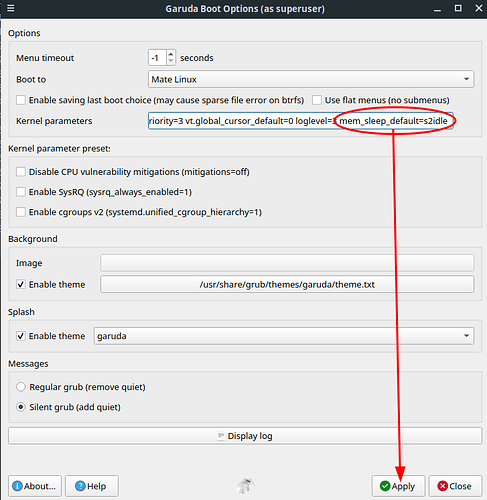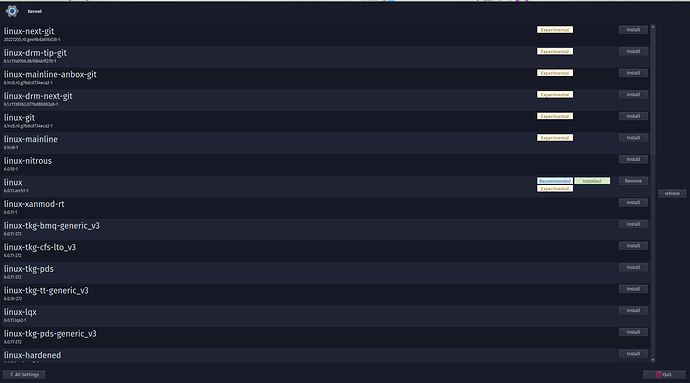Hello Garuda users.
i am facing a problem … whenever my computer wake-up form sleep / add also hibernate it get freeze in sddm login screen.
then i turned on automatic login after sleep. but still i am getting sucked in a black screen with cursor.
i have tried those following … but they doesn’t worked for me…(specially the first one i think might be reliable).
#System gives black screen after going to sleep for 3 times
#No login screen on wake from sleep after recent updates
#Distorted Graphics after waking up from Sleep mode
in arch-wiki i found that … and i thing it might be the reason of happening this… because i have to set the hibernate after installing (not selecting at the time of installing)…
https://wiki.archlinux.org/title/Power_management/Suspend_and_hibernate#Troubleshooting
Suspend/hibernate does not work, or does not work consistently
Sometimes the screen goes black due to device initialization from within the initramfs. Removing any modules you might have in Mkinitcpio#MODULES and rebuilding the initramfs, can possibly solve this issue, specially graphics drivers for early KMS. Initializing such devices before resuming can cause inconsistencies that prevents the system resuming from hibernation. This does not affect resuming from RAM. Also, check the blog article best practices to debug suspend issues.
Removing any modules you might have in Mkinitcpio#MODULES an`d rebuilding the initramfs, can possibly solve this issue, specially graphics drivers for early KMS …but which to remove i can’t understand…which causing problem …even i don’t have kms hook enabled…
.
here is my /etc/mkinitcpio.conf hook line…
HOOKS="base udev autodetect modconf block resume keyboard keymap consolefont plymouth filesystems grub-btrfs-overlayfs
and my garuda inxi…
╰─λ garuda-inxi
perl: warning: Setting locale failed.
perl: warning: Please check that your locale settings:
LANGUAGE = "",
LC_ALL = (unset),
LC_ADDRESS = "en_IN",
LC_NAME = "en_IN",
LC_MONETARY = "en_IN",
LC_PAPER = "en_IN",
LC_IDENTIFICATION = "en_IN",
LC_TELEPHONE = "en_IN",
LC_MEASUREMENT = "en_IN",
LC_TIME = "en_IN",
LC_NUMERIC = "en_IN",
LANG = "en_GB.UTF-8"
are supported and installed on your system.
perl: warning: Falling back to the standard locale ("C").
System:
Kernel: 6.2.2-zen1-1-zen arch: x86_64 bits: 64 compiler: gcc v: 12.2.1
parameters: BOOT_IMAGE=/@/boot/vmlinuz-linux-zen
root=UUID=c19fafa2-a09f-4395-9c2d-19b3ee84c467 rw rootflags=subvol=@
quiet quiet splash rd.udev.log_priority=3 vt.global_cursor_default=0
loglevel=3 resume=/dev/sda2 ibt=off
Desktop: KDE Plasma v: 5.27.2 tk: Qt v: 5.15.8 info: latte-dock
wm: kwin_x11 vt: 1 dm: SDDM Distro: Garuda Linux base: Arch Linux
Machine:
Type: Desktop System: Gigabyte product: H110M-S2 v: N/A
serial: <superuser required>
Mobo: Gigabyte model: H110M-S2-CF v: x.x serial: <superuser required>
UEFI: American Megatrends v: F21 date: 06/09/2017
CPU:
Info: model: Intel Core i3-6100 bits: 64 type: MT MCP arch: Skylake-S
gen: core 6 level: v3 note: check built: 2015 process: Intel 14nm family: 6
model-id: 0x5E (94) stepping: 3 microcode: 0xF0
Topology: cpus: 1x cores: 2 tpc: 2 threads: 4 smt: enabled cache:
L1: 128 KiB desc: d-2x32 KiB; i-2x32 KiB L2: 512 KiB desc: 2x256 KiB
L3: 3 MiB desc: 1x3 MiB
Speed (MHz): avg: 800 min/max: 800/3700 scaling: driver: intel_pstate
governor: powersave cores: 1: 800 2: 800 3: 800 4: 800 bogomips: 29598
Flags: avx avx2 ht lm nx pae sse sse2 sse3 sse4_1 sse4_2 ssse3 vmx
Vulnerabilities: <filter>
Graphics:
Device-1: NVIDIA GT218 [GeForce G210] driver: nouveau v: kernel non-free:
series: 340.xx status: legacy (EOL) last: release: 340.108 kernel: 5.4
xorg: 1.20 arch: Tesla process: 40-80nm built: 2006-13 pcie: gen: 1
speed: 2.5 GT/s lanes: 16 ports: active: VGA-1 empty: DVI-I-1,HDMI-A-1
bus-ID: 01:00.0 chip-ID: 10de:0a60 class-ID: 0300 temp: 47.0 C
Display: x11 server: X.Org v: 21.1.7 with: Xwayland v: 22.1.8
compositor: kwin_x11 driver: X: loaded: nouveau unloaded: modesetting
alternate: fbdev,nv,vesa dri: nouveau gpu: nouveau display-ID: :0
screens: 1
Screen-1: 0 s-res: 1366x768 s-dpi: 96 s-size: 361x203mm (14.21x7.99")
s-diag: 414mm (16.31")
Monitor-1: VGA-1 model: LG (GoldStar) HD serial: <filter> built: 2017
res: 1366x768 hz: 60 dpi: 85 gamma: 1.2 size: 410x230mm (16.14x9.06")
diag: 470mm (18.5") ratio: 16:9 modes: max: 1366x768 min: 720x400
API: OpenGL v: 3.3 Mesa 22.3.6 renderer: NVA8 direct-render: Yes
Audio:
Device-1: Intel 100 Series/C230 Series Family HD Audio vendor: Gigabyte
driver: snd_hda_intel v: kernel alternate: snd_soc_avs bus-ID: 00:1f.3
chip-ID: 8086:a170 class-ID: 0403
Device-2: NVIDIA High Definition Audio driver: snd_hda_intel v: kernel
pcie: gen: 1 speed: 2.5 GT/s lanes: 16 bus-ID: 01:00.1 chip-ID: 10de:0be3
class-ID: 0403
Sound API: ALSA v: k6.2.2-zen1-1-zen running: yes
Sound Server-1: PulseAudio v: 16.1 running: no
Sound Server-2: PipeWire v: 0.3.66 running: yes
Network:
Device-1: Realtek RTL8111/8168/8411 PCI Express Gigabit Ethernet
vendor: Gigabyte driver: r8169 v: kernel pcie: gen: 1 speed: 2.5 GT/s
lanes: 1 port: d000 bus-ID: 02:00.0 chip-ID: 10ec:8168 class-ID: 0200
IF: enp2s0 state: up speed: 1000 Mbps duplex: full mac: <filter>
Drives:
Local Storage: total: 1.13 TiB used: 36.26 GiB (3.1%)
SMART Message: Unable to run smartctl. Root privileges required.
ID-1: /dev/sda maj-min: 8:0 vendor: Crucial model: CT240BX500SSD1
size: 223.57 GiB block-size: physical: 512 B logical: 512 B speed: 6.0 Gb/s
type: SSD serial: <filter> rev: 056 scheme: GPT
ID-2: /dev/sdb maj-min: 8:16 vendor: Western Digital
model: WD10EZEX-60WN4A0 size: 931.51 GiB block-size: physical: 4096 B
logical: 512 B speed: 6.0 Gb/s type: HDD rpm: 7200 serial: <filter>
rev: 1A01 scheme: MBR
Partition:
ID-1: / raw-size: 64.52 GiB size: 64.52 GiB (100.00%)
used: 16.48 GiB (25.5%) fs: btrfs dev: /dev/sda3 maj-min: 8:3
ID-2: /boot/efi raw-size: 600 MiB size: 598.8 MiB (99.80%)
used: 608 KiB (0.1%) fs: vfat dev: /dev/sda1 maj-min: 8:1
ID-3: /home raw-size: 125.51 GiB size: 125.51 GiB (100.00%)
used: 19.77 GiB (15.8%) fs: btrfs dev: /dev/sda4 maj-min: 8:4
ID-4: /var/log raw-size: 64.52 GiB size: 64.52 GiB (100.00%)
used: 16.48 GiB (25.5%) fs: btrfs dev: /dev/sda3 maj-min: 8:3
ID-5: /var/tmp raw-size: 64.52 GiB size: 64.52 GiB (100.00%)
used: 16.48 GiB (25.5%) fs: btrfs dev: /dev/sda3 maj-min: 8:3
Swap:
Kernel: swappiness: 133 (default 60) cache-pressure: 100 (default)
ID-1: swap-1 type: zram size: 7.71 GiB used: 734.5 MiB (9.3%)
priority: 100 dev: /dev/zram0
ID-2: swap-2 type: partition size: 8.79 GiB used: 0 KiB (0.0%)
priority: -2 dev: /dev/sda2 maj-min: 8:2
Sensors:
System Temperatures: cpu: 41.0 C mobo: N/A gpu: nouveau temp: 48.0 C
Fan Speeds (RPM): N/A
Info:
Processes: 217 Uptime: 36m wakeups: 0 Memory: 7.71 GiB
used: 3.51 GiB (45.5%) Init: systemd v: 253 default: graphical
tool: systemctl Compilers: gcc: 12.2.1 Packages: pm: pacman pkgs: 1414
libs: 366 tools: octopi,pamac,paru Shell: fish v: 3.6.0 default: Bash
v: 5.1.16 running-in: konsole inxi: 3.3.25
Garuda (2.6.15-1):
System install date: 2023-03-04
Last full system update: 2023-03-05
Is partially upgraded: No
Relevant software: snapper NetworkManager mkinitcpio
Windows dual boot: No/Undetected
Failed units:



